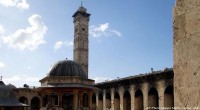
This post, written by Natasha Kieval, Programs Intern, is the fourth in our #Syriasly series highlighting different aspects of the Syrian conflict. Check out our previous posts: a timeline of the US response, the perspective of a Syrian-American activist, and an overview of the conflict.
Each day the Syrian conflict appears to become more complicated, with increasing numbers of actors and new groups forming. One of these complications is the issue of religious minorities. Syria has a majority of Sunni Muslims, which make up 75% of the population. However, many minorities exist: Alawites consist 12% of the population, 10% are Christian, 4% are Druze, and non-Alawite Shi’a Muslims and Jews make up less than 1% of the population each.
Before the civil war, under Assad’s Ba’athist regime, these minorities enjoyed relative religious freedom. The Assad family is Alawaite, and therefore part of the non-Sunni religious minority. To maintain power, Assad implemented laws and policies to protect minorities. The Ba’ath party opposed religious influence on state matters and emphasized a secular Syrian nationalism. As such, as the violence broke out minorities were assumed to be supporters of the regime, and have been under extreme pressure to choose sides. Minorities struggle between fear of a new regime that could potentially be less accepting of religious differences and anger at the Assad regime for its human rights abuses.
During the House Foreign Affairs Committee hearing a few weeks ago, Chairman Smith of New Jersey spoke of the implications of this conflict for Syria’s religious minorities. In hisopening remarks, Rep. Smith spoke of his concerns for the targeting of religious minorities, citing the fact that 1 in 5 refugees is Christian though Christians are only 1 in 10 Syrians.
Thomas Melia of the Department of State spoke of the Assad regime’s attempt to drive a wedge between Syria’s Sunni Muslim majority and religious minorities. The regime commits 80-90% of “human rights atrocities” in the conflict. Therefore, minorities are increasingly obliged to take up arms against the regime. Melia confirmed that there is targeting of minorities in Syria. Massacres of Shi’a citizens are occurring, over 1,000 mosques have been destroyed, and Christians are driven from their homes. Sunnis who want democracy are seen by the opposition as “unbelievers” who deserve to be punished. This puts minorities in the middle of this conflict as they are targeted from both sides.
Zuhdi Jasser of the US Center on International Religious Freedom added to Melia’s comments, mentioning the regime’s characterization of the opposition forces as “Sunni extremists” who will create an Islamist state that will not allow religious minorities. Jasser added further that the regime’s claim that the Syrian conflict is a sectarian battle is untrue. The regime is capitalizing on minorities to further its aims. Additionally, sectarian violence is spilling over into neighboring countries like Lebanon.
The issue of religious minorities being trapped in the middle is not a new one – Al-Jazeera featured this op-ed in 2011. Increased targeting of minorities, however, is a concern, and is yet another complication in this horrific conflict.
